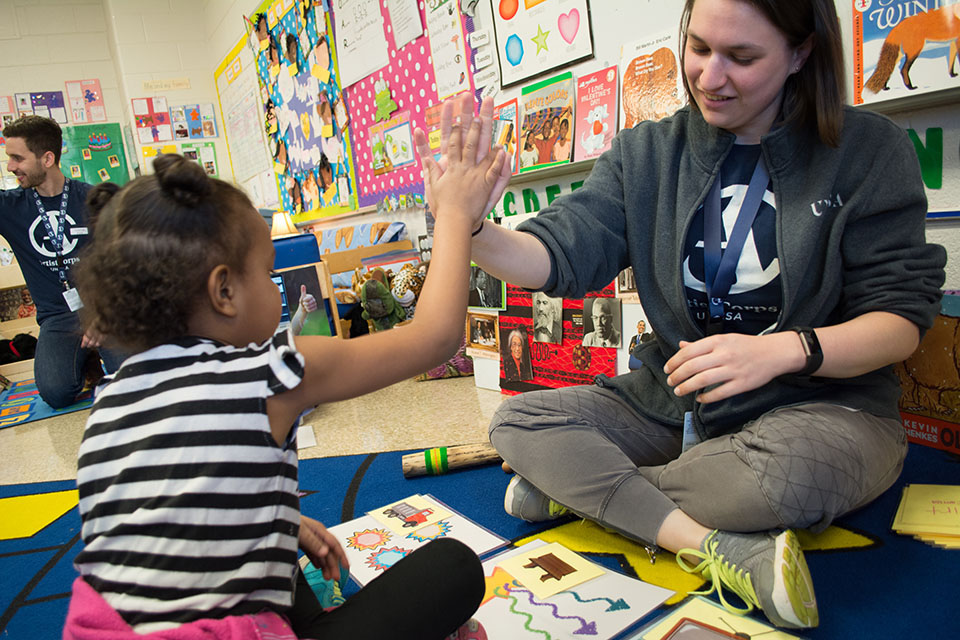B-b-bunny: A New Approach to Pre-K Phonics (Part 2)
Author: Kendra Harding
The Wolf Method is a pre-k phonetics program developed by drama faculty and long-time ArtistCorps member Ann-Louise Wolf. The program currently serves over twenty pre-k students – mostly non-native English speakers – at Easton Elementary School.
UNCSA ArtistCorps members work alongside Ann-Louise to help the pre-k students develop critical pre-reading skills and phonological awareness, using techniques that derive from Ann-Louise’s expertise as a voice and diction professional. By working with students before they learn to read, the program hopes to help close the reading achievement gap by third grade, something that has been shown to be an indicator of overall academic success.

Image Credit: Haydee Thompson
I spoke with Ann-Louise recently about her work at Easton, how it came into being, and where it’s headed next.
“I ended up in a first-grade transitional bilingual class at another school purely by happenstance, and their teacher was a native Spanish speaker. She was delighted to have any native English speaker walk into her room,” she says with a warm smile. “She handed me this notebook full of Dibbles exercises — Dibbles is the phonics instruction program that the school system uses — and said ‘Please do this with them because we’re struggling.’”
Once Ann-Louise began digging into this curriculum, she understood why: Dibbles requires a certain level of understanding of the unique vowel sounds of English, and requires a standardized perception of the number of sounds within words, or phonemic segmentation.
“They would do fine on words like ‘beet’ and ‘cup,’” Ann-Louise explains, “but then they’d get to words like ‘road’ which has a diphthong in the middle. The answer that the Dibbles sheet wanted would be three [sounds]: r, oa,and d. The answer that the native Spanish speakers would hear was four: r, o, u, d. There was this really big communication breakdown where the native Spanish speakers were perceiving sound differently than the native English speakers. Phonics instruction is based on how you perceive and create sound.”
Ann-Louise did her best to help the first-grade students, but says she was limited in what she could accomplish due to how far along in the established reading curriculum students were.
“It became apparent that by first grade there was so much emphasis on reading with letters that I was already interfering with their curriculum,” she explains. “But by helping them establish a baseline of English sounds before they learned to read I would be more helpful. So, Rebecca Nussbaum helped me reach out to Easton about their pre-k program where they have a lot of non-native English speakers, and here we are!”
The Wolf Method is a curriculum with a mission: to prepare emerging readers with a foundational understanding of English sounds and how they’re made before letters are introduced.
“I see this instruction filling a few different needs,” Ann-Louise says of the program. “Primary among them, it fills the gap between phonemic perception and phonics instruction.
“Phonics instruction is based on the assumption that all students perceive and assign meaning to sounds the same way, which we have long known isn’t true. The Wolf Method is designed to make sure that students are perceiving and making speech sounds the way that most phonics instruction and reading assessments assume they will.
Now in its second year, the program continues to develop.
“The biggest shift in the second year is that we’re moving a lot faster overall,”
Ann-Louise says. “Some of that is because we’ve got most of our supplies made already
this year, but a lot of it is because I know exactly what I want to teach and in what
order — I’m not inventing it, I’m refining it.”
Looking toward the future, Ann-Louise envisions a program that begins in pre-k and
goes through second grade, helping students meet their early literacy milestones prior
to the critical third-grade year.
While laying critical foundations for literacy is the overarching goal of The Wolf Method, there is a deeper reason Ann-Louise founded the program: to help students develop the skills they need to become lifelong learners.
“Through the Wolf Method, the students are made to feel special, important, and able to achieve success,” she says. “We want to establish in them a desire to learn and grow. We work toward this every single time we serve them. I consider the year a success if the students come out of the program as empowered capable learners. That’s the most important need we can fill.”
April 01, 2019





